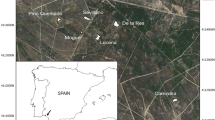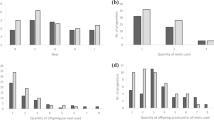Abstract
Mating behaviour is an important component of species’ life histories. Knowledge of natural patterns of mating can lead also to more effective management strategies for populations of conservation concern. Despite a high conservation profile many aspects of the biology of the common dormouse (Muscardinus avellanarius) remain unknown, potentially limiting present conservation efforts. We determine the mating behaviour of M. avellanarius at two woodland sites in the UK: (1) Bontuchel (a natural population in Wales) and (2) Wych (a population in England that was established by reintroducing captive-bred animals) by genotyping mothers and litters at a panel of 10 microsatellite loci. Adult female body weight positively correlates with litter size and no apparent reproductive skew was evident. We found that multiple mating by female dormice is prevalent at both sites, with litters containing three or more offspring sired by multiple fathers; moreover, multiple mating is adopted by released animals even after a period of captive breeding where females are mated singly or as a breeding pair. We also present evidence for low proportion of fathers identified in our samples that probably related to unsampled individuals and/or larger than anticipated population sizes. This first report of mating behaviour in M. avellanarius highlights the role of genetic studies to uncover species’ reproductive behaviours and include these data for conservation management.


Similar content being viewed by others
References
Banks SC, Lindenmayers D, Ward J, Taylor AC (2005) The effects of habitat fragmentation via forestry plantation establishment on spatial genotypic structure in the small marsupial carnivore, Anthecinus agilis. Mol Ecol 14:1667–1680
Bateman AJ (1948) Intra-sexual selection in Drosophila. Heredity 2:349–368
Bertolino A, Viano C, Currado I (2001) Population dynamics, breeding patterns and spatial use of the garden dormouse Eliomys quercinus in an Alpine habitat. J Zool Lond 253:513–521
Borkowska A (2010) Seasonal variation of reproductive success under female philopatry and male-biased dispersal in a common vole population. Behav Process 86:39–45
Borkowska A, Borowski Z, Krysiuk K (2010) Multiple paternity in free-living root voles (Microtus oeconomus). Behav Process 82:211–213
Bright PW, Morris PA, Mitchell JT (2006) The dormouse conservation handbook. English Nature, Great Britain
Büchner S, Tubbe SM, Triese SD (2003) Breeding and biological data for the common dormouse (Muscardinus avellanarius) in Eastern Saxony (Germany). Acta Zool Acad Sci Hung 49:19–26
Clutton-Brock TH, McAuliffe K (2009) Female mate choice in mammals. Quat Rev Biol 84:3–27
Clutton-Brock TH, Vincent ACJ (1991) Sexual selection and the potential reproductive rates of males and females. Nature 351:58–60
Courchamp F, Clutton-Brock T, Grenfell B (1999) Inverse density dependence and the Allee effect. Trend Ecol Evol 14:405–410
Crawford JC, Liu ZW, Nelson TA, Nielsen CK, Blooniquist CK (2008) Microsatellite analysis of mating and kinship in beavers (Castor Canadensis). J Mammal 89:575–581
Dean MD, Ardlie KG, Nachman MW (2006) The frequency of multiple paternity suggests that sperm competition is common in house mice (Mus domesticus). Mol Ecol 15:4141–4151
DeWoody JA, Fletcher DE, Wilkins SD, Nelson WS, Avise JC (2000) Genetic monogamy and biparental care in an externally fertilizing fish, the largemouth bass (Micropterus salmoides). Proc R Soc Lond B267:2431–2437
Feldheim KA, Gruber SH, Ashley MV (2002) Breeding biology of lemon sharks at a tropical nursery lagoon. Proc R Soc Lond B269:1655–1662
Firman RC, Simmons LW (2008) The frequency of multiple paternity predicts variation in testes size among island populations of house mice. J Evol Biol 21:1524–1533
Goudet J (2001) FSTAT; a program to estimate and test gene diversities and fixation indices, version 2.9.3.2. Available via http://www.unil.ch/izea/softwares/fstat.html. Assessed 30 June 2009
Hardy OJ, Vekemans X (2002) SPAGeDi: a versatile computer program to analyse spatial genetic structure at the individual or population levels. Mol Ecol Notes 2:618–620
Hauber ME, Lacey EA (2005) Bateman’s principle in cooperatively breeding vertebrates: the effects of non-breeding alloparents on variability of female and male reproductive success. Integr Comp Biol 45:903–914
Hohoff C, Franzen K, Sachser N (2003) Female choice in a promiscuous wild guinea pig, the yellow-toothed cavy (Galea musteloides). Behav Ecol Sociobiol 53:341–349
Holand Ø, Weladji RB, Gjøstein H, Kumpula J, Smith ME, Nieminen M, Røed KH (2004) Reproductive effort in relation to maternal social rank in reindeer Rangifer tarandus. Behav Ecol Sociobiol 57:69–76
Holt M, Vangen O, Farstad W (2004) Components of litter size in mice after 110 generations of selection. Reproduction 127:587–592
Hoogland JL (1995) The black-tailed prairie dog: social life of a burrowing mammal. University of Chicago Press, Chicago
IUCN (2009) European Mammal Assessment. Available via http://ec.europa.eu/environment/nature/conservation/species/ema/. Assessed 11 May 2009
Jennions MD, Petrie M (2000) Why do females mate multiply? A review of the genetic benefits. Biol Rev 75:21–64
Jonsson P, Agrell J, Koskela E, Mappes T (2002) Effects of litter size on pup defence and weaning success of neighbouring bank voles females. Can J Zool 80:1–5
Jule KR, Leaver LA, Lea SEG (2008) The effects of captive experience on reintroduction survival in carnivores: a review and analysis. Biol Conserv 141:355–363
Juŝkaitis R (2003) Abundance dynamics and reproduction success in the common dormouse, Muscardinus avellanarius, populations in Lithuania. Folia Zool 52:239–248
Keane B (1990) Dispersal and inbreeding avoidance in the white-footed mouse, Peromyscus leucopus. Anim Behav 40:143–152
Keane B, Waser PM, Creel SR, Creel NM, Elliott LF, Minchella DJ (1994) Subordinate reproduction in dwarf mongooses. Anim Behav 47:65–75
Keil A, Sacher N (1998) Reproductive benefits from female promiscuous mating in a small mammal. Ethol 104:897–903
Kennis J, Sluydts V, Leirs H, Van Hooft P (2008) Polyandry and polygyny in an African rodent pest species, Mastomys natalensis. Mammal 72:150–160
Kinahan AA, Pillay N (2008) Dominance status influences female reproductive strategy in a territorial African rodent Rhabdomys pumiio. Behav Ecol Sociobiol 62:579–587
Lane JE, Boutin S, Gunn MR, Slate J, Coltman DW (2008) Female multiple mating and paternity in free-ranging North American red squirrels. Anim Behav 75:1927–1937
Laurent L, Perrin N (2003) Inbreeding avoidance through kin recognition: choosy females boost male dispersal. Am Nat 162:638–652
Lee PL, Hays GC (2004) Polyandry in a marine turtle: females make the best of a bad job. Proc Nat Acad Sci USA 101:6530–6535
Macdonald DW, Tattersall F (2003) The state of Britain’s mammals. Mammal Trust UK/People’s Trust for Endangered Species, Great Britain
Marin G, Pilastro A (1994) Communally breeding dormice Glis glis are close kin. Anim Behav 47:1485–1487
Marshall TC, Slate J, Kruuk LEB, Pemberton JM (1998) Statistical confidence for likelihood-based paternity inference in natural populations. Mol Ecol 7:639–655
Mateo JM (2003) Kin recognition in ground squirrels and other rodents. J Mammal 84:1163–1181
Matocq MD, Lacey EA (2004) Philopatry, kin clusters, and genetic relatedness in a population of woodrats (Neotoma macrotis). Behav Ecol 15:647–653
Md. Naim D, Kemp SJ, Telfer S, Watts PC (2009) Isolation and characterization of 10 microsatellite loci in the common dormouse Muscardinus avellanarius. Mol Ecol Res 9:1010–1012
Md. Naim D, Telfer S, Tatman S, Bird S, Kemp SJ, Watts PC (submitted) Reintroduced common dormice, Muscardinus avellanarius, retain their natural dispersal behaviour
Moore JA, Nelson NJ, Keall SN, Daugherty CH (2007) Implications of social dominance and multiple paternity for the genetic diversity of a captive-bred reptile population (tuatara). Conserv Genet 9:1243–1251
Moran S, Turner PD, O’Reilly C (2009) Multiple paternity in the European hedgehog. J Zool 278:349–353
Morris PA (2004) Dormice. British Natural History Series. Whittet Books Ltd, Suffolk
Nevo E, Amir E (1964) Variation in reproduction and hibernation patterns of the forest dormouse. J Mammal 45:69–87
Nievergelt CM, Digby LJ, Ramakrishnan U, Woodruff DS (2000) Genetic analysis of group composition and breeding system in a wild common marmoset (Callithrix jacchus) population. Int J Primatol 2:11–20
Pilastro A (1992) Communal nesting between breeding females in a free-living population of fat dormouse Glis glis. Ital J Zool 59:63–68
Pilastro A, Tavecchia G, Marin G (2003) Long living and reproduction skipping in the fat dormouse. Ecology 84:1784–1792
Pillay N (2002) Father-daughter recognition and inbreeding avoidance in the striped mouse, Rhabdomys pumilio. Mamm Biol 67:212–218
Pusey A, Wolf M (1996) Inbreeding avoidance in animals. Trends Ecol Evol 11:201–206
Raymond M, Rousset F (1995) GENEPOP, version 1.2. Population genetics software for exact tests and ecumenicisms. J Hered 86:248–249
Reeve HK, Westneat DF, Noon WA, Sherman PW, Aquadro CF (1990) DNA fingerprinting reveals high-levels of inbreeding in colonies of the eusocial naked mole-rat. Proc Ant Acad Sci USA 87:2496–2500
Schilling P, North W, Bogart R (1968) The effect of sire on litter size in mice. J Hered 59:351–352
Schmoll T, Dietrich V, Winkel W, Epplen JT, Lubjuhn T (2003) Long-term fitness consequences of female extra-pair matings in a socially monogamous passerine. Proc R Soc Lond B 270:259–264
Schulte-Hostedde AI, Millar JS, Gibbs HL (2002) Female-biased sexual size dimorphism in the yellow-pine chipmunk (Tamias amoenus): sex specific patterns of annual reproductive success and survival. Evolution 56:2519–2529
Schulte-Hostedde AI, Millar JS, Gibbs HL (2004) Sexual selection and mating patterns in a mammal with female-biased sexual dimorphism. Behav Ecol 15:351–356
Simmons LW (2005) The evolution of polyandry: sperm competition, sperm selection, and offspring viability. Ann Rev Ecol Syst 36:125–145
Solomon NG, Keane B (2007) Reproductive strategies in female rodents. In: Wolff JO, Sherman PW (eds) Rodent societies: an ecological and evolutionary perspective, 1st edn. University of Chicago Press, Chicago and London, pp 42–57
Stockley P (2003) Female multiple mating behaviour, early reproductive failure and litter size variation in mammals. Proc R Soc Lond B 270:271–278
Van Oosterhout C, Hutchinson WF, Wills DPM, Shipley P (2004) MICRO-CHECKER: software for identifying and correcting genotyping errors in microsatellite data. Mol Ecol Notes 4:535–538
Walsh PS, Metzger DA, Higuchi R (1991) Chelex® 100 as a medium for simple extraction of DNA for PCR-based typing from forensic material. Biotechniques 10:506–513
Wang J, Santure AW (2009) Parentage and sibship inference from multi-locus genotype data under polygamy. Genetics 181:1579–1594
Waser PM, DeWoody JA (2006) Multiple paternity in philoptric rodent: the interation of competition and choice. Behav Ecol 17:971–978
Wauters L, Dhondt AA (1989) Body weight, longevity and reproductive success in red Squirrels (Sciurus vulgaris). Oikos 58:637–651
Wolff JO, Macdonald DW (2004) Promiscous females protect their offspring. Trends Ecol Evol 19:27–134
Yasui Y (1998) The “genetic benefits” of female multiple mating reconsidered. Trends Ecol Evol 13:246–250
Zeh JA, Zeh DW (2001) Reproductive mode and the genetic benefits of polyandry. Anim Behav 61:1051–1063
Acknowledgments
We thank all of the members of the Northwest Dormouse Partnership, particularly Sarah Bird, Scott Wilson, Rhian Hughes, Sue Tatman, Iolo Lloyd and the Forestry Commission, as well as all of the volunteers that have helped during survey work. This work was funded by Malaysian Government and Universiti Sains Malaysia for Academic Staff Training Scheme (ASTS).
Author information
Authors and Affiliations
Corresponding author
Electronic supplementary material
Below is the link to the electronic supplementary material.
Rights and permissions
About this article
Cite this article
Naim, D.M., Telfer, S., Sanderson, S. et al. Prevalence of multiple mating by female common dormice, Muscardinus avellanarius . Conserv Genet 12, 971–979 (2011). https://doi.org/10.1007/s10592-011-0200-6
Received:
Accepted:
Published:
Issue Date:
DOI: https://doi.org/10.1007/s10592-011-0200-6




